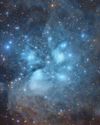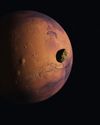“ The universe as a whole is expanding”
1 Earth Earth’s diameter is 12,756 kilometres (7,926 miles). The Moon orbits Earth at an average of 384,400 kilometres (238,855 miles).
2 Solar system The outermost planet in the Solar System, Neptune, orbits the Sun at a distance of 4.5 billion kilometres (2.8 billion miles).
3 living local Stars in our local region of space are separated by light years – tens of trillions of kilometres. The brightest star in the sky, Sirius, is 8.6 light-years away.
4 home galaxy Our Sun and Solar System, and all the stars in our sky, are members of the Milky Way – a vast spiral of stars that’s roughly 120,000 light-years across.
5 Grouping up The Milky Way is a major member of a small galaxy cluster called the Local Group, occupying a volume of space about 10 million light-years across.
6 Big cluster The Local Group is an outlying region of our local galaxy supercluster, sometimes called the Virgo or Laniakea Supercluster. It is over 100 million light-years long.
7 empty space The Virgo Supercluster is part of a local supercluster complex a billion light-years across. At this level, the large-scale structure of filaments and empty voids begins to emerge.
8 Far-reaching The observable universe has a diameter of about 93 billion light-years based on the current locations of regions that we can see.
Esta historia es de la edición Issue 120 de All About Space.
Comience su prueba gratuita de Magzter GOLD de 7 días para acceder a miles de historias premium seleccionadas y a más de 9,000 revistas y periódicos.
Ya eres suscriptor ? Conectar
Esta historia es de la edición Issue 120 de All About Space.
Comience su prueba gratuita de Magzter GOLD de 7 días para acceder a miles de historias premium seleccionadas y a más de 9,000 revistas y periódicos.
Ya eres suscriptor? Conectar

MYSTERIES OF THE UNI WHERE ARE ALL THE SPIRAL GALAXIES?
There are far fewer spiral galaxies than elliptical ones in the Supergalactic Plane, and scientists are keen to discover why

ZOMBIE STARS
+10 OTHER TERRIFYING SPACE OBJECTS

HOW TO BEAT LIGHT POLLUTION
Thought it was impossible to observe the wonders of the night sky from towns and cities? Think again. Follow our tips and tricks on successfully observing through sky glow

15 STUNNING STAR CLUSTERS
These beautiful stellar groupings are spattered across the cosmos

Eileen Collins "It was a difficult mission...we were the first to see Mir"
Having served as both the first female pilot and first female commander of NASA's Space Shuttle, Collins boosted the involvement of women in space exploration to a whole new level

MARS LEAKS FASTER WHEN IT'S CLOSER TO THE SUN
The Red Planet has lost enough water to space to form a global ocean hundreds of kilometres deep

FUTURE TECH KANKOH-MARU
This ambitious reusable spacecraft will be capable of taking 50 people to and from orbit

THE FINAL FRONTIER
Beyond the reach of the Sun is a fascinating region of the cosmos that were only just beginning to explore

A long-lost moon could explain Mars' weird shape and extreme terrain
A long-lost moon could explain why Mars is so different from the other rocky planets in the Solar System. Today Mars has two tiny moons.

A sprinkling of cosmic dust may have helped kick-start life on Earth
Cosmic dust may have helped kick-start life on Earth. New findings challenge a widely held assumption that this wasn't a plausible explanation.